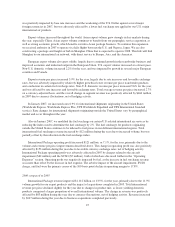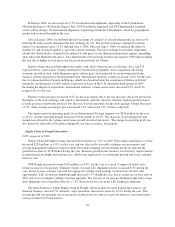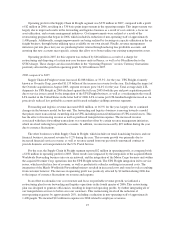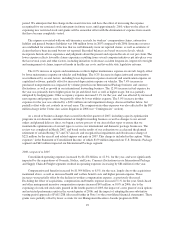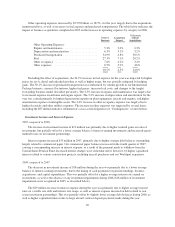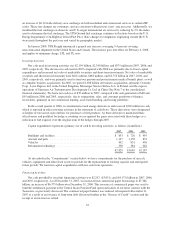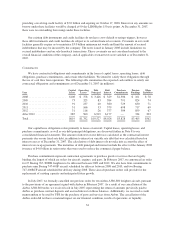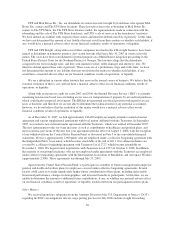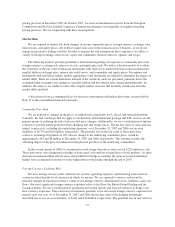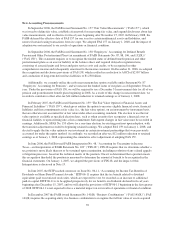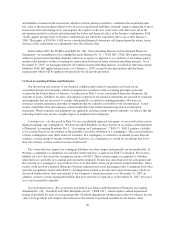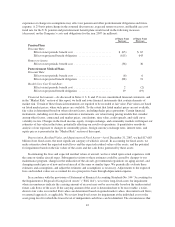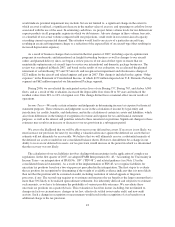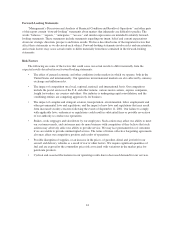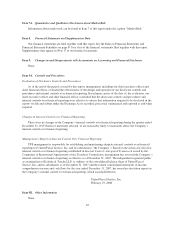UPS 2007 Annual Report Download - page 50
Download and view the complete annual report
Please find page 50 of the 2007 UPS annual report below. You can navigate through the pages in the report by either clicking on the pages listed below, or by using the keyword search tool below to find specific information within the annual report.Pension fundings represent the anticipated required cash contributions that will be made to the UPS IBT
Pension Plan, which was established upon ratification of the national master agreement with the Teamsters. The
UPS IBT Pension Plan is the only UPS-sponsored pension or postretirement benefit plan with a material
minimum funding requirement as of December 31, 2007. The pension funding requirements were estimated
under the provisions of the Pension Protection Act of 2006 and the Employee Retirement Income Security Act of
1974, using discount rates, asset returns, and other assumptions appropriate for this plan. To the extent that the
funded status of the UPS IBT pension plan in future years differs from our current projections, the actual
contributions made in future years could materially differ from the amounts shown in the table above.
The contractual payments due under the “other liabilities” column primarily includes commitment payments
related to our investment in certain partnerships. The table above does not include approximately $355 million of
unrecognized tax benefits that have been recognized as liabilities in accordance with FASB Interpretation No. 48,
“Accounting for Uncertainty in Income Taxes—an Interpretation of FASB Statement No. 109” (“FIN 48”),
because we are uncertain if or when such amounts will ultimately be settled in cash. In addition, although we
have recognized and disclosed unrecognized tax benefits in accordance with FIN 48, we also have outstanding
recognized tax benefits in excess of the recorded liabilities such that we do not believe a net contractual
obligation exists to the taxing authorities. FIN 48 is discussed further in Note 13 to the consolidated financial
statements.
As of December 31, 2007, we had outstanding letters of credit totaling approximately $2.177 billion issued
in connection with routine business requirements. As of December 31, 2007, we had unfunded loan commitments
totaling $860 million associated with our financial business.
We believe that funds from operations and borrowing programs will provide adequate sources of liquidity
and capital resources to meet our expected long-term needs for the operation of our business, including
anticipated capital expenditures, such as commitments for aircraft purchases, for the foreseeable future.
Contingencies
We are a defendant in a number of lawsuits filed in state and federal courts containing various class-action
allegations under state wage-and-hour laws. In one of these cases, Marlo v. UPS, which has been certified as a
class action in a California federal court, plaintiffs allege that they improperly were denied overtime, and seek
penalties for missed meal and rest periods, and interest and attorneys’ fees. Plaintiffs purport to represent a class of
1,200 full-time supervisors. In August 2005, the court granted summary judgment in favor of UPS on all claims,
and plaintiff appealed the ruling. In October 2007, the appeals court reversed the lower court’s ruling. We have
denied any liability with respect to these claims and intend to vigorously defend ourselves in this case. At this
time, we have not determined the amount of any liability that may result from this matter or whether such liability,
if any, would have a material adverse effect on our financial condition, results of operations, or liquidity.
In another case, Cornn v. UPS, which was certified as a class action in a California federal court, plaintiffs
allege that they were improperly denied wages and/or overtime and meal and rest periods. Plaintiffs purport to
represent a class of approximately 23,600 drivers and seek back wages, penalties, interest and attorneys’ fees.
UPS settled this matter in full for a total payment of $87 million in the second quarter of 2007. The settlement
had no impact on our 2007 operating results as it was accrued for previously during the third quarter of 2006.
In another case, Hohider v. UPS, which in July 2007 was certified as a class action in a Pennsylvania federal
court, plaintiffs have challenged certain aspects of the Company’s interactive process for assessing requests for
reasonable accommodation under the Americans with Disabilities Act. Plaintiffs purport to represent a class of
over 35,000 current and former employees, and seek backpay, compensatory and punitive damages, as well as
attorneys’ fees. In August 2007, the Third Circuit Court of Appeals granted the Company’s Petition to hear the
appeal of the trial court’s recent certification order. The appeal will likely take one year. At this time, we have
not determined the amount of any liability that may result from this matter or whether such liability, if any,
would have a material adverse effect on our financial condition, results of operations, or liquidity.
35


